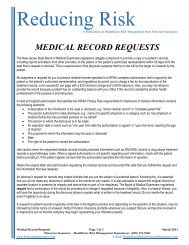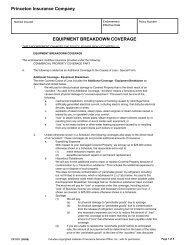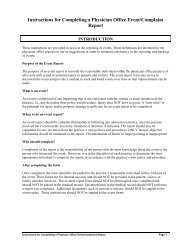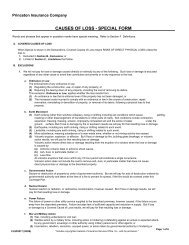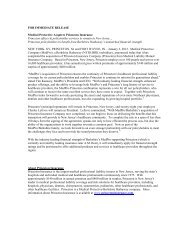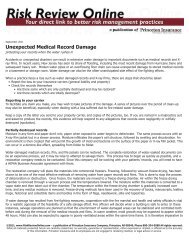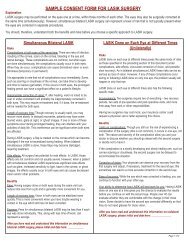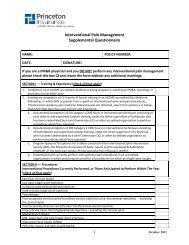Reducing Risk - Princeton Insurance
Reducing Risk - Princeton Insurance
Reducing Risk - Princeton Insurance
Create successful ePaper yourself
Turn your PDF publications into a flip-book with our unique Google optimized e-Paper software.
<strong>Reducing</strong> <strong>Risk</strong><br />
A Publication on HealthCare <strong>Risk</strong> Management from <strong>Princeton</strong> <strong>Insurance</strong><br />
<strong>Risk</strong> Alert – Kenalog Injections<br />
Physician Beware:<br />
Even an Old Favorite Drug Can Pose Significant <strong>Risk</strong><br />
Description<br />
To many physicians and patients, Kenalog is a medication with a long history of relatively problem-free administration (as long as<br />
the prescribing physician and patients observe routine precautions for steroid use). However, injectable Kenalog poses risks that<br />
physician, staff, and patient must be aware of. A side effect which has recently led to claims is tissue atrophy.<br />
Internet blog entries written by patients about their Kenalog side effects describe dents in their upper arms or buttocks that are<br />
‘huge’, ‘the size of a baseball’, or ‘the size of an orange’ i . They describe spending significant time and money on trips to other<br />
physicians to find out what caused the dent, and what might be done to remove it.<br />
Though these ‘dents’ caused by tissue atrophy are usually the primary allegation in a Kenalog claim, other complaints are also<br />
voiced. Side effects such as cardio-vascular problems, severe pain, menometrorrhagia, skin discoloration, headache, and a variety<br />
of other complaints have been reported.<br />
In some cases, physicians who use Kenalog injections for their patients were not aware of the possibility of tissue atrophy or some<br />
of these other side effects. Since they were unaware they could not advise their staff (CMAs or nurses) of the risks attached to the<br />
injections, nor could they advise the patients of potential risks. Tissue atrophy then came as a surprise to all involved, and the<br />
patient expressed even more anger because they felt that the doctor should have known about the side effect they experienced.<br />
This is an ideal situation for a claim.<br />
There is a great deal of information on Kenalog and its side effects on package inserts and on internet information sites.<br />
Unfortunately, there is limited reference to tissue atrophy in connection with intramuscular injection of Kenalog on Kenalog-specific<br />
sites. Only Drugs.com makes specific reference to the need for a deep intramuscular injection to avoid ‘local atrophy’. ii Drug<br />
package inserts from the manufacturer do not mention tissue atrophy for the 10 mg intramuscular dose; however, the 40 mg<br />
package insert states: “The suggested initial dose is 60 mg, injected deeply into the gluteal muscle. Atrophy of subcutaneous<br />
fat may occur if the injection is not properly given.” These package inserts were updated in November, 2007. If a practice is not in<br />
the habit of checking for changes, or if their pharmaceutical representative did not inform them of a change, then this update could<br />
have gone unnoticed.<br />
It is important for physicians who give their patients intramuscular injections of Kenalog to take steps which can protect their<br />
patients and reduce potential liability. Following are a list of the specific risks encountered in this situation and recommendations<br />
for reducing those risks.<br />
This situation represents several areas of risk. There may be:<br />
<strong>Risk</strong>s<br />
• Potential for patient and physician complacency with a medication which has been on the market for many years<br />
• Practitioners who are unaware of potential side effects of the injected medication because they are uninformed of updated<br />
package inserts<br />
<strong>Risk</strong> Alert – Kenalog Injections Page 1 of 2 October 2010<br />
<strong>Princeton</strong> <strong>Insurance</strong> – HealthCare <strong>Risk</strong> Management Department: (609) 452-9404<br />
www.<strong>Princeton</strong><strong>Insurance</strong>.com<br />
E-mail: HealthCare<strong>Risk</strong>@<strong>Princeton</strong><strong>Insurance</strong>.com
<strong>Reducing</strong> <strong>Risk</strong><br />
• Real or perceived inadequate communication between practitioner and patient, such as complaints of:<br />
• Little or no information given on potential side effects<br />
• Little or no support given in response to side effects<br />
• Patients not told the specific medication they are receiving<br />
• Patients are actively communicating their experiences with each other through blogs, but may not be communicating their<br />
unhappiness as clearly to their physicians<br />
These are risks which must be addressed, specifically in this situation, but also on a broader scale for all medications which a<br />
practitioner may be using.<br />
Recommendations<br />
For practices that give Kenalog injections, the following steps can help make the patient part of the decision-making team and<br />
reduce liability.<br />
• All Kenalog injections should be given according to manufacturer’s directions, that is, deep into the muscle; they should<br />
never be given in the deltoid, only in the buttocks.<br />
• Before giving a Kenalog injection to a patient, a physician must discuss the medication with the patient, including its risks,<br />
benefits, side effects, and complications.<br />
• It is beneficial to have a written sheet which also describes the medication, its risks, benefits, side effects, and<br />
complications.<br />
• The written description sheet can also include a signature line for patient and a witness. In this way the sheet is used as<br />
an informal consent. Therefore, the original signed copy should be placed in the patient’s chart and a photocopy should<br />
be given to the patient.<br />
Comment<br />
In some <strong>Princeton</strong> cases which involved Kenalog injections, the staff member who injected the patient was a CMA. All physicians<br />
must be aware of the New Jersey Board of Medical Examiner (BME) regulationsiii<br />
regarding CMA injections.<br />
Though CMAs are allowed to give these injections under BME regulations, they must be conscious of the risks involved, and of the<br />
proper method of administration. Before giving the injection they should make sure that the physician has educated the patient<br />
about the risks and given the patient a written description of those risks, as noted above.<br />
Working as a team, physician, staff, and patient can still successfully use a medication which has proved itself to be effective for<br />
many years. Success requires communication, knowledge of the issues, and a focus on patient safety from all involved.<br />
For more information about reducing risk at your practice, please view our risk management newsletter at www.<strong>Risk</strong>ReviewOnline.com. To<br />
access additional <strong>Reducing</strong> <strong>Risk</strong> documents, visit our website at www.<strong>Princeton</strong><strong>Insurance</strong>.com and click on “<strong>Risk</strong> Management – Publications.”<br />
This material is not to be construed as establishing professional practice standards or providing legal advice. Compliance with any of<br />
the recommendations contained herein in no way guarantees the fulfillment of your obligations as may be required by any local, state or<br />
federal laws, regulations or other requirements. Readers are advised to consult a qualified attorney or other professional regarding the<br />
information and issues discussed herein, and for advice pertaining to a specific situation.<br />
i http://www.medications.com/se/kenalog<br />
ii Kenalog-40, Drugs.com, http://www.drugs.com/pro/kenalog-40.html<br />
iii http://www.state.nj.us/lps/ca/bme/bmelaws.pdf. Page 179-180.<br />
<strong>Risk</strong> Alert – Kenalog Injections Page 2 of 2 October 2010



